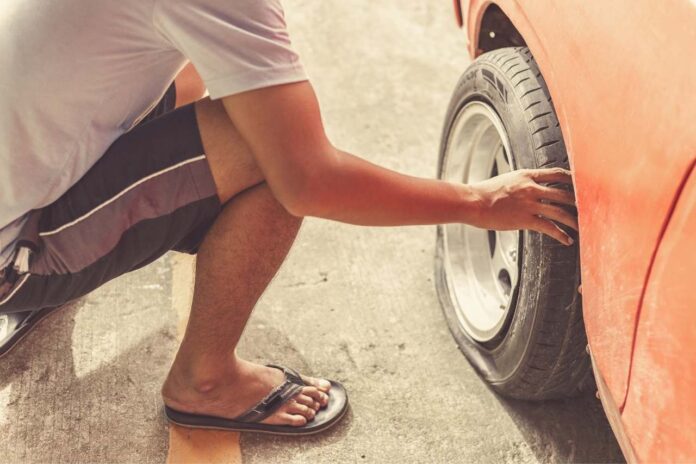According to personal experience, a conventional car can drive for a short distance on a flat tire before the tire disintegrates. Before the rim is likewise damaged beyond repair, the tire would have to be changed. If there is no other alternative, only drive on a flat tire at very low speeds. To many, these are remarkable figures – and in most cases, these flat tires will be sufficient to get you home, or at the very least to a location where the tire can be repaired or (as is generally the case) replaced. Even so, it’s crucial to be cautious and aware of the limitations of uninflated and flat tires when you get the idea of “How far can I drive on a flat tire?”
After you get a flat tire, you can drive the car for quite a distance. It might last for tens of thousands of miles. However, unless it is a run-flat tire, a flat tire will frequently be ruined in a few yards. Shortly after, the rim will be irreparably destroyed. Steel rims will corrode faster than alloy rims.
The sidewall of a tire isn’t sturdy enough to keep the wheel off the ground unless you’re driving on a run-flat-tire. This is accomplished by the air inside; the walls only aid in the containment of the air.
The weight of the automobile presses down on the sidewall as the air escapes; forcing it to flex significantly more than it was designed to. The more you drive on it, the more likely it is that the flexing may permanently damage the sidewall.
A flat tire isn’t often signaled by a loud noise or other visible symptoms. If you drive over a nail, for example, you could be driving on a punctured tire for weeks at a time. The air would most likely be held in place by a nail, but when the air was gradually released, your tire would suffer a slow puncture.
This, however, is usually dependent on the tire, your pace, and the surface you’re riding on. Tires with thicker sidewalls will last longer in general, but not by much. The less structural support a tire has, the more it wears. If you’ve worn the rubber down to the steel belt beneath it, the tire will fail catastrophically faster than a new tire with just a puncture.
How Flat Is The Tire?
How flat is the tire? This is a difficult question to answer. The tire may separate from the rim if there is a catastrophic blowout. Even a slow flat should be driven as rapidly as possible to the side of the road.
The issue is that your vehicle will be exerting its weight on the rim, destroying the tire (which may have been plugged or repaired). A flat tire does not provide much (if any) cushioning to the rim. So, the rim will quickly eat through it, leaving you driving on the rim. It’s very simple to damage that rim; therefore, you’ll need to purchase a new tire as well as a new wheel.
How Far Can I Drive On a Flat Tire?
If you notice a low-pressure condition with one of your tires, find a safe area to pull over as quickly as feasible. If the tire is only low on air and not flat, it may most likely be mended with little or no damage to the rim. The casing has most certainly been damaged. And the tire is hazardous if it has been driven on ‘flat’ with no air. It will be necessary to inspect and potentially replace the rim.
Even if you think how far can I drive on a flat tire, you must pull over to the side of the road as quickly as possible and replace any damaged tires. If you can’t pull over right away, use your hazard lights.
Unfortunately, with today’s low-profile tires and sophisticated suspensions, some people may find it difficult to tell if their tire(s) are low on air. It’s a good idea to visually inspect them before getting in your car and driving, as well as once a month or so with a tire gauge.
However, there are times when you can tell you’re driving on a flat tire because your driving control has been compromised. Also, you can’t go a long distance without stopping.
What Does A Slipping Transmission Feel Like? Read here.
Steps to Follow When You Have a Flat Tire
When you have a puncture or a flat tire while driving, it can be frightening and stressful. If you do get a flat tire, though, make sure to follow these simple steps:
- The most important thing to remember is to stay calm while taking speedy action. If at all feasible, move your vehicle out of the direction of oncoming traffic and pull into a safe spot. You can analyze the damage to your tire and plan your next steps from here.
- The next step is to determine whether your tire requires repair or replacement. It’s possible that your local garage can fix the tire. However, in order to drive your vehicle to the mechanic, you will need to replace your tire. You will need to change your tire if you have a spare in the boot of your car.
How Far A Flat-Run Tire Go After Puncture?
Run-Flat-Tires are capable of traveling at the manufacturer’s suggested speeds and distances. This is normally around 80 kilometers per hour; it should be plenty to get you out of difficulty once you’ve had a puncture.
The heat generated by friction on the tire during corning, as well as all the other forces acting on it while in motion, is the reason for the minimal speed. More detailed information can be found in the manufacturer’s guidelines, which can vary. So, the question of “how far can I drive on a flat tire?” is most probably to be solved.
Recommended For You:
